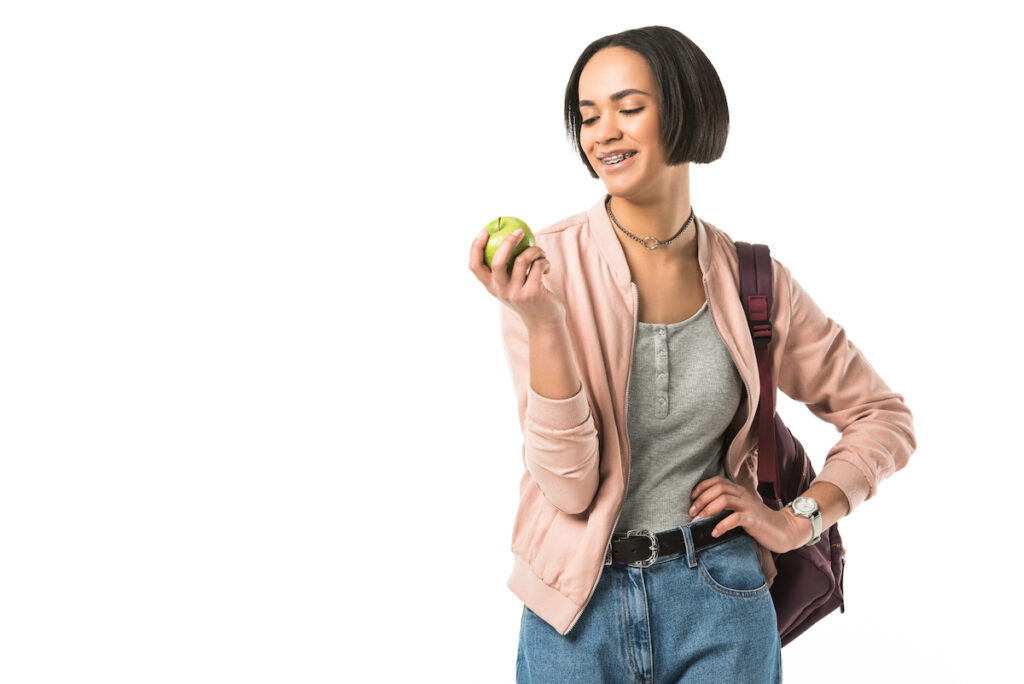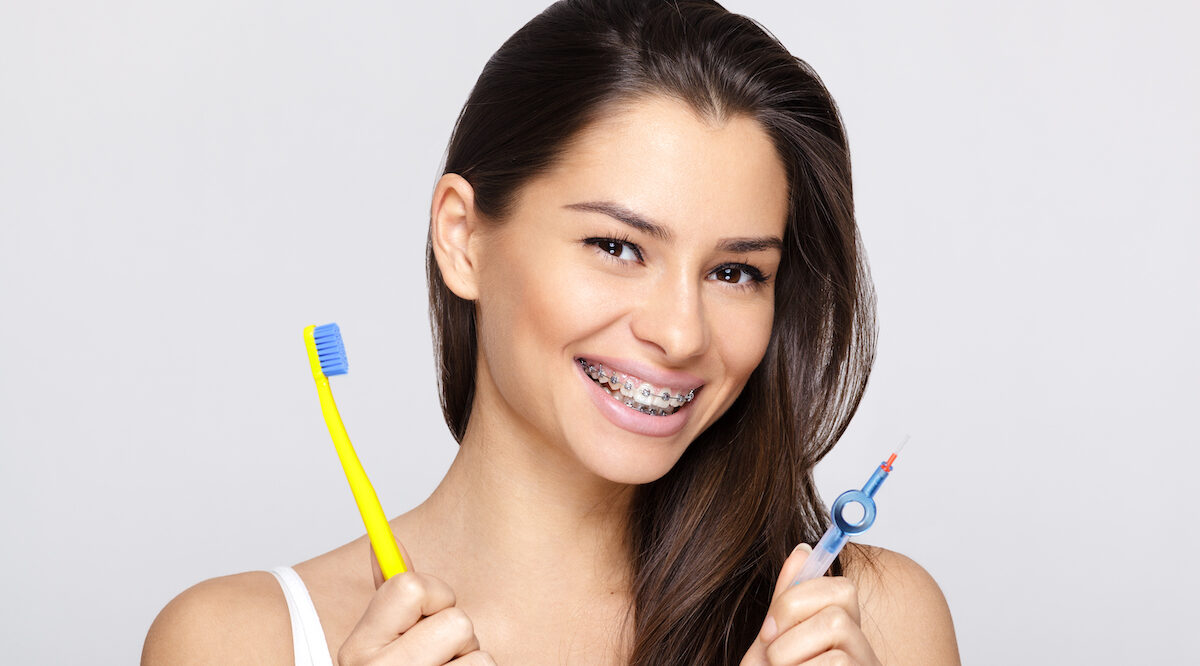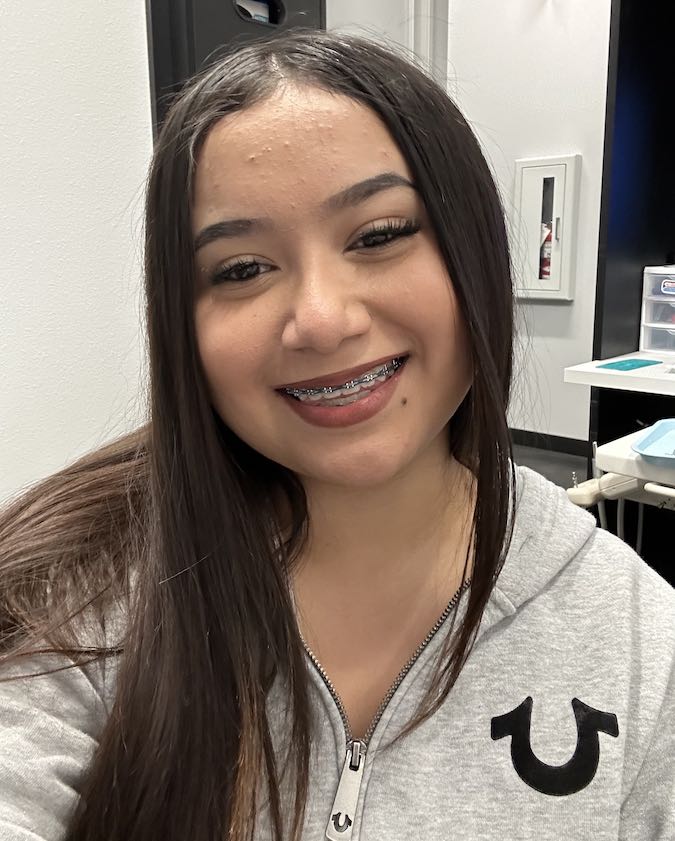Anyone who has braces knows that eating can be a challenge. The braces might feel uncomfortable, food can get caught in them, and — if you bite something too hard — the braces may break. With so many potential problems, you might be wondering: how do you safely eat with braces? In this guide, we'll cover everything you need to know about this topic from the foods you should eat to the foods you should avoid. Here's a closer look at our top tips and tricks.
How Do Braces Work?
Before we explore how to eat with braces, let's examine how braces work. Put simply, braces are an orthodontic treatment made up of brackets and wires. Designed to fix malocclusion (or crooked and crowded teeth), they work by gently placing pressure on the teeth and jaws. Over time, the teeth slowly move into the correct position. The ultimate goal is a straight, healthy smile.
While braces are commonly associated with adolescence, adults often need them as well. No matter how old the patient is, it's normal to experience some discomfort as teeth shift. To avoid hurting sensitive teeth, it's important to adjust your eating habits when using braces.
How Do You Eat With Braces?
Eating with braces is no easy feat. In addition to dealing with extra sensitive teeth, you have to be careful not to damage the braces themselves. Here are a few helpful tips to keep in mind:
Eat slowly. When you first get braces, chewing might seem difficult. Eating slowly can help minimize any discomfort.
Take small bites. Cut your food into small pieces. This will help you avoid stretching your jaw or chewing too much food at once.
Use your side teeth. If your front teeth are too sensitive, use your side teeth to chew instead.
Along with changing the way you eat, you should be mindful of the foods you're consuming.
What Can You Eat When You First Get Your Braces?
You can expect your teeth to be the most sensitive when you first get braces. For many people, it may feel impossible to put any pressure on the teeth without feeling uncomfortable. Thus, it's best to stick with room-temperature, soft foods that are easy to chew and swallow.
Best Soft Foods for Eating With Braces
Soft foods are great for braces patients because they require minimal chewing. Here are some of our top recommendations:
Oatmeal. Oatmeal is a nutritious, filling snack or breakfast that's great for braces patients. Make it more flavorful by adding soft toppings such as sliced bananas.
Soup. There's no chewing involved in soup, which makes it one of the easiest foods to eat. Just be sure the temperature isn't too hot so you don't burn your mouth.
Mashed potatoes. Mashed potatoes are extremely soft and require little chewing. They can work as either a main dish or a snack.
Pasta. If you're looking for a filling dinner that's easy to eat, pasta fits the bill. You can spruce it up by adding sauce and soft, boiled vegetables.
Yogurt. When it comes to soft snacks, yogurt takes the cake. Best of all, it comes in a bunch of different flavors that allow you to pick what you prefer.
As you get used to the braces, the discomfort will generally decrease. But for the first few days, you'll need to be extra careful.

What Kind of Snacks Can You Eat With Braces?
Once your teeth become less sensitive, you can expand your diet. While you don't have to limit yourself to super soft foods, it's still a good idea to avoid anything that's too hard or chewy. Here are some of the best snacks for people with braces:
Ice cream. When you first get braces, ice cream may be too cold to eat. Once your teeth adjust to the braces, ice cream will once again become a delicious and easy-to-eat treat.
Bread. Soft bread is a delicious snack that won't interfere with your braces. You can elevate it by enjoying it with butter or olive oil.
Veggies and dip. If you're looking for a healthy snack that won't hurt your braces, vegetables are a good choice. Enjoy them steamed or grilled alongside hummus, ranch, or your favorite dip.
Cheese. Soft cheeses, such as cottage cheese or string cheese, are a great snack for braces patients. You can eat them plain or with soft crackers.
Smoothies. Smoothies are an excellent way to increase your fruit intake while dealing with braces. If you don't care for smoothies, you can still enjoy fruit — just stick with softer options, like bananas, blueberries, and citrus fruits.
Due to their relatively soft textures, these snacks rarely trigger sensitivity or damage braces. Unfortunately, the same can't be said for other foods.
Can You Break Your Braces?
Braces may be strong enough to move your teeth, but that doesn't mean they're indestructible. Certain foods can get lodged in your braces, causing the wires or brackets to loosen. In some cases, they may even break an entire bracket. Here are a few foods you should not eat with braces:
Hard and sticky candy. Hard or sticky candies, such as lollipops and taffy, can get stuck in and damage your braces. If you're craving a sweet treat, try a healthy candy alternative such as Zollipops. They are safe for braces and sugar-free, vegan, and allergy-friendly.
Nuts and seeds. Because of their small size, nuts and seeds can quickly get stuck in braces. This can cause both wires and brackets to move.
Popcorn. As with nuts and seeds, it's very easy for popcorn kernels to get lodged in the wire of your braces. If they're not removed, they can lead to bleeding or swollen gums.
Hard snacks. Foods that are very hard (such as pretzels or certain chips) can exert lots of pressure on your braces, causing them to break.
If your braces become loose or damaged, Risas accepts orthodontics patients as walk-ins to ensure there are no wires sticking out that could cut you.
Changing How You Eat With Braces
Getting braces doesn't mean you have to completely reinvent your diet. However, you will need to make some minor adjustments to avoid hurting your teeth and braces. These include consuming soft foods, avoiding hard and sticky substances, and eating more slowly. By changing your eating habits, you can help ensure your braces stay in good shape throughout the treatment. The sooner you complete treatment, the sooner you can enjoy your brand-new, bright smile.
Are you interested in learning more about braces? Whether you need braces yourself or want eating tips for your teenager, our team at Risas Dental is here to help. Schedule an appointment today!
Frequently Asked Questions
How long after getting braces can you eat normal foods?
There's no set answer to how long you have to stick with soft, room-temperature foods after getting braces. It depends on how comfortable your teeth are. Some people will consume soft foods for a few days, while others will limit their diet for a couple of weeks.
Why is it so hard to eat with braces?
Eating with braces is difficult for two main reasons. First, the brackets apply pressure that makes your teeth more sensitive to harder, chewier foods. Second, the wires and brackets that make up the braces are vulnerable to breaking. This means you have to be extra careful to avoid hurting your teeth or braces.
What junk food can you eat with braces?
You can eat any junk food that isn't too hard or sticky. Top options include ice cream, frozen yogurt, soft cookies, and chocolate. If you're looking for healthy junk food alternatives that are safe for braces, Zollipops are a great choice.
Why does it feel so weird to chew with your braces?
If you're not used to the sensation of braces, chewing may feel weird at first. It can also be uncomfortable because your teeth are shifting positions. However, this strange feeling should go away over time.

